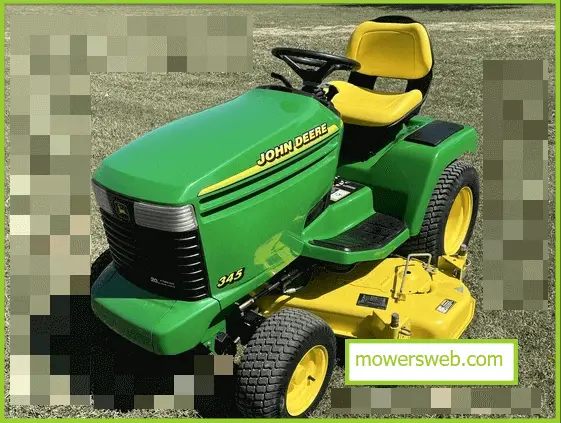The fuel pump in a John Deere 345 is an essential part of the fuel system. Its primary function is to draw fuel from the tank and deliver it to the carburetor or fuel injection system at the required pressure.
It ensures that the engine receives a consistent supply of fuel for optimal performance.
However, if the fuel pump malfunctions, it can lead to various issues.
In this post, we will discuss the common fuel pump problems that owners of the John Deere 345 may encounter, their symptoms, and possible solutions.
Let’s jump in.

John Deere 345 Fuel Pump Problems
1. Engine Stalling
A failing fuel pump may cause the engine to stall unexpectedly, especially during high-demand situations or when operating at full throttle.
2. Difficulty Starting
If you experience difficulty starting your John Deere 345, it could indicate a problem with the fuel pump. The engine may crank but struggle to start.
3. Engine Misfires
A faulty fuel pump can result in intermittent fuel delivery, leading to engine misfires. This can cause rough idling and poor performance.
4. Low Power or Performance Issues
When the fuel pump is not delivering an adequate amount of fuel, the engine may lack power, resulting in decreased performance.
5. Fuel Leakage
A damaged or worn-out fuel pump can develop leaks, leading to fuel seepage or puddles under the tractor.
Read John Deere Low Viscosity Hy-Gard Equivalent(9 Best)
Causes of Fuel Pump Problems in John Deere 345
1. Contaminated Fuel
The presence of dirt, debris, or water in the fuel can clog the fuel pump and affect its performance.
2. Age and Wear
Over time, the fuel pump’s internal components can wear out, leading to decreased efficiency or complete failure.
3. Lack of Maintenance
Insufficient maintenance, such as not replacing the fuel filter regularly, can put additional strain on the fuel pump, leading to premature failure.
Read Can I Use Trufuel in My Lawn Mower(5 Benefits)
How to Fix Fuel Pump John Deere 345 Problems
1. Check Fuel Pressure
Use a fuel pressure gauge to measure the pressure output of the fuel pump. Compare the readings with the manufacturer’s specifications.
2. Inspect for Fuel Leaks
Check the fuel lines and connections for any signs of leakage. Replace any damaged or worn-out components.
3. Test Fuel Pump Relay
The fuel pump relay controls the power supply to the fuel pump. Test the relay to ensure it is functioning correctly.
Read Best Oil for John Deere Riding Mower(Top 3 Oils)
How to Replace the Fuel Pump in John Deere 345
- Prepare the Tractor: Park the tractor on a flat surface, engage the parking brake, and disconnect the battery.
- Access the Fuel Pump: Locate the fuel pump, usually mounted on or near the engine. Remove any necessary components obstructing access.
- Disconnect Fuel Lines: Carefully disconnect the fuel lines from the pump, ensuring you capture any fuel that may spill.
- Remove the Old Pump: Unbolt the fuel pump from its mounting bracket and remove it from the tractor.
- Install the New Pump: Position the new fuel pump and secure it to the mounting bracket. Reconnect the fuel lines.
- Test the Fuel Pump: Reconnect the battery and turn the ignition on to test the new fuel pump’s functionality.
John Deere Fuel Pump Troubleshooting
If you encounter persistent fuel pump problems in your John Deere 345, consider the following troubleshooting steps:
1. Clean or Replace Fuel Filter
A clogged fuel filter can restrict fuel flow and put a strain on the fuel pump. Clean or replace the filter as necessary.
2. Inspect Fuel Lines
Check the fuel lines for any blockages or restrictions. Ensure they are properly connected and not damaged.
3. Check Fuel Tank Vent
A blocked fuel tank vent can create a vacuum and impede fuel flow. Clean the vent or replace it if necessary.
Read John Deere 2305 Problems(7 Quick Ways To Fix)
Preventive Measures for Maintaining the Fuel Pump
To maintain the fuel pump’s performance and prolong its lifespan, consider the following preventive measures:
- Use Clean Fuel: Ensure that the fuel you use is clean and free from contaminants. Regularly check and clean the fuel tank.
- Replace Fuel Filter: Follow the manufacturer’s recommended intervals for replacing the fuel filter to prevent debris from reaching the fuel pump.
- Keep the Fuel Tank Full: Running the tractor with a low fuel level can expose the fuel pump to air, potentially causing damage. Keep the tank adequately filled.
Read John Deere 2010 Problems(5 Quick Ways To Fix)
John Deere Fuel Pump Installation
Tools and Materials Needed:
- New fuel pump (compatible with your John Deere model)
- Socket wrench set
- Screwdrivers (both flathead and Phillips)
- Pliers
- Fuel line clamps or pinch-off pliers
- Safety glasses
- Shop for rags or paper towels.
- Gloves
- Safety stands or ramps (if needed)
Steps:
- Safety First: Ensure that your vehicle or equipment is parked on a level surface and that the engine is turned off. Also, make sure you’re in a well-ventilated area and wearing appropriate safety gear.
- Disconnect the battery. This step is important to prevent any accidental electrical contact during the installation process. Disconnect the negative terminal of the battery.
- Locate the Old Fuel Pump: Depending on your John Deere model, the fuel pump may be located on the engine itself or within the fuel tank. Refer to your owner’s manual or the service manual for exact locations and instructions.
- Relieve Fuel Pressure: If your vehicle has a fuel injection system, you’ll need to relieve the fuel pressure before proceeding. This typically involves locating the fuel pressure relief valve and carefully releasing pressure. Be cautious, as fuel might spray out.
- Disconnect Fuel Lines: Using fuel line clamps or pinch-off pliers, clamp off the fuel lines to prevent fuel leakage. Then, carefully disconnect the fuel lines from the old fuel pump. Make sure to catch any fuel that may spill and dispose of it safely.
- Remove the Old Fuel Pump: Depending on its location, you might need to remove bolts, clips, or other fasteners that secure the old fuel pump in place. Keep track of these parts for reinstallation.
- Install the New Fuel Pump: Position the new fuel pump in place and secure it with the appropriate fasteners. Reconnect any wiring or connectors that were disconnected.
- Reconnect Fuel Lines: Attach the fuel lines to the new fuel pump, ensuring they are properly seated and secure. Double-check the connections.
- Reconnect the battery: Reconnect the negative terminal of the battery.
- Test for Leaks: Turn the ignition to the ON position without starting the engine. Listen for the fuel pump priming and check for any fuel leaks around the connections you’ve worked on. If everything seems fine, you can proceed.
- Start the Engine: Start the engine and let it idle for a few minutes. Monitor for any unusual sounds or signs of fuel leakage. If everything appears normal, you’ve successfully installed the new fuel pump.
- Cleanup: Dispose of any rags, tools, or materials used in a safe and environmentally friendly manner.
Importance of Regular Maintenance
Regular maintenance is crucial for preventing fuel pump problems and ensuring the longevity of your John Deere 345.
By following the recommended maintenance schedule, including fuel system inspections and filter replacements, you can identify issues early and take corrective action promptly.
John Deere 345 fuel pump location
In the John Deere, the fuel pump is located within the fuel tank. This means that the fuel pump is positioned at the bottom of the fuel tank itself.
To access and replace the fuel pump, you would typically need to:
- Ensure safety measures, including wearing appropriate gear and disconnecting the spark plug wire.
- Remove any parts that might be obstructing access to the fuel tank.
- Disconnect the fuel line that connects to the fuel pump to prevent fuel leakage.
- Take off the fuel tank by undoing any mounting bolts or brackets securing it.
- Once the fuel tank is removed, you will be able to reach the fuel pump, which is situated at the bottom of the tank.
- Disconnect the old fuel pump, replace it with a new one, and securely attach it.
- Reconnect the fuel line back to the new fuel pump.
- Reinstall the fuel tank and secure it with the appropriate fasteners.
- Reattach the spark plug wire that was disconnected earlier.
- Check for any fuel leaks by turning the ignition to the ON position.
- Start the engine and let it idle, observing for any unusual sounds or fuel leakage.
- Dispose of any used materials properly after completing the process.
Read John Deere MFWD Problems(5 Easy Ways To Fix)
FAQs
How often should I replace the fuel filter in my John Deere 345?
It is recommended to replace the fuel filter in your John Deere 345 according to the manufacturer’s guidelines.
Typically, it is advisable to replace the fuel filter every 100 hours of operation or at least once a year, whichever comes first.
Regularly replacing the fuel filter helps ensure proper fuel flow and prevents contaminants from reaching the fuel pump.
Can a clogged fuel filter cause the fuel pump to fail?
Yes, a clogged fuel filter can potentially cause the fuel pump to fail. When the fuel filter becomes clogged, it restricts the flow of fuel to the pump, increasing the strain on the pump.
Over time, this extra strain can lead to premature wear and ultimately result in the failure of the fuel pump.
Therefore, it is essential to replace the fuel filter regularly to prevent such issues.
What should I do if I suspect a fuel pump problem in my tractor?
If you suspect a fuel pump problem in your tractor, there are a few steps you can take:
- Check for common symptoms such as engine stalling, difficulty starting, engine misfires, low power, or fuel leakage.
- Conduct a visual inspection of the fuel lines and connections for any signs of damage or leaks.
- Measure the fuel pressure using a fuel pressure gauge to determine if the pump is delivering the required pressure.
- If you are unsure or unable to diagnose the issue yourself, it is advisable to seek assistance from a qualified technician who can further inspect and diagnose the fuel pump problem.
Read How to Replace Mower Belt on John Deere D130 Diagram
Can I clean a fuel pump instead of replacing it?
No, generally, it is not recommended to clean a fuel pump as a long-term solution. Fuel pumps are intricate mechanical devices with internal components that can wear out or become damaged.
Cleaning may temporarily alleviate some issues caused by contamination, but it does not address wear or mechanical failures.
It is best to replace a faulty fuel pump to ensure optimal performance and reliability.
How can I avoid fuel contamination in my John Deere 345?
- Purchase fuel from reputable sources to minimize the risk of contaminated fuel.
- Store fuel in clean and properly sealed containers to prevent the entry of dirt, water, or other contaminants.
- Regularly inspect and clean the fuel tank to remove any accumulated debris or sediment.
- Use a quality fuel filter and replace it at the recommended intervals to ensure efficient filtration and prevent contaminants from reaching the fuel pump.
Is it necessary to replace the fuel pump relay during a fuel pump replacement?
While it is not always necessary to replace the fuel pump relay during a fuel pump replacement, it is recommended to inspect and test the relay.
The fuel pump relay controls the power supply to the fuel pump, and a faulty relay can lead to fuel pump issues.
If the relay is showing signs of wear or has a history of malfunctioning, it is advisable to replace it to ensure the proper functioning of the new fuel pump.
Are there any aftermarket fuel pumps available for John Deere 345?
Yes, there are aftermarket fuel pumps available for the John Deere 345. A
Aftermarket fuel pumps are produced by third-party manufacturers and may offer alternatives to original equipment manufacturer (OEM) fuel pumps.
When considering an aftermarket fuel pump, it is essential to ensure compatibility, quality, and reliability.
Consult with reputable dealers or suppliers who specialize in John Deere parts to explore suitable aftermarket options for your tractor.
Read 5 common John Deere 5045D Problems(With Solutions)
Final Remarks
Understanding the common fuel pump problems in the John Deere 345 lawn tractor is essential for maintaining its performance.
By recognizing the symptoms, diagnosing the issues, and taking appropriate actions, you can ensure that your fuel system operates smoothly.
Regular maintenance, including fuel filter replacements and keeping the fuel tank clean, will help prevent fuel pump problems and extend the lifespan of your John Deere 345.
Read John Deere Z915E: 4 Common Problems and How to Fix Them




